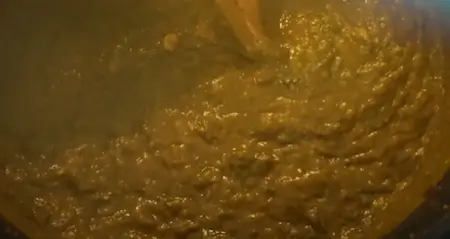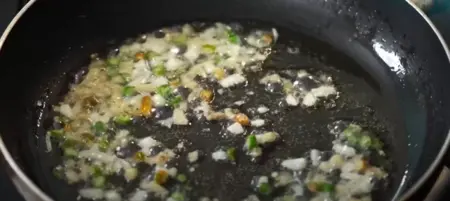
Sai Bhaji Meal Recipe

30 mins

2-3 people

15 mins
Introduction
Growing up, one of my fondest memories revolves around the aroma of Sai Bhaji filling our kitchen. It wasn't just a dish; it was a symbol of love and tradition passed down through generations in my family. The first time I discovered Sai Bhaji, I was mesmerized by its flavors—a perfect blend of spinach, fenugreek leaves, and other nutritious vegetables. It became a staple in our household, not just for its taste but also for its health benefits. Every bite reminded me of home, of warmth, and of the rich culinary heritage that defines us.
Sai Bhaji, a traditional Sindhi dish, holds a special place in my heart. This wholesome meal, packed with the goodness of spinach, fenugreek leaves, and other vegetables, is not just a recipe; it's a journey through culinary tradition. With its roots deeply embedded in Sindhi culture, Sai Bhaji has transcended generations, captivating taste buds and nourishing souls along the way. Let me take you on a flavorful ride through the recipe of this beloved dish.
Recipe of Sai Bhaji Meal
Portions serving: 5-6 people
Preparation time: 15 minutes
Cooking time: 40 minutes
Ingredients:
- 3 cups palak (spinach)
- 1/2 cup methi (fenugreek leaves)
- 1/4 cup sour spinach (optional)
- Chana dal (soaked) - quantity as per preference
- 1/4 cup lauki (bottle gourd), rough cut
- 1/4 cup carrot, rough cut
- Dill leaves - quantity as per preference
- Salt - to taste
- 1 tsp turmeric
- 1 tsp chopped garlic
- 2 chopped onions
- 1/2 inch chopped ginger
- 1 green chili
- 1 tbsp sunflower oil
- 1 tbsp tamarind pulp (if sour spinach is not used)
- Chopped tomato - quantity as per preference
Instructions:
-
Soak the Chana Dal:
Begin by soaking the chana dal in water for about 30 minutes. This ensures the lentils cook evenly and become soft and flavorful. -
Sauté Onions, Ginger, and Green Chilies:
Heat sunflower oil in a pan. Add chopped onions and cook until they turn light brown and release their aroma. Then, add chopped ginger and green chilies, sautéing until fragrant. -
Add Vegetables:
Introduce the rough-cut lauki and carrot to the pan. Let them cook alongside the sautéed onions, ginger, and chilies. -
Seasoning:
Sprinkle turmeric and salt to taste over the vegetables. This will enhance the flavors and provide a vibrant yellow color to the dish. -
Add Greens:
Add the chopped spinach, methi, and dill leaves to the pan. The greens will not only add freshness but also boost the nutritional value of the meal. -
Optional Tamarind:
If you’re not using sour spinach, add tamarind pulp at this stage. This will introduce a tangy twist to the Sai Bhaji. -
Pressure Cook:
Add a little water to the pan to maintain moisture. Transfer the mixture to a pressure cooker and cook for 1 or 2 whistles, until the vegetables and lentils are tender. -
Simmer and Mash:
Once the pressure cooker is opened, let the Sai Bhaji simmer. Use a wooden spoon to gently mash the vegetables, blending all the flavors and enhancing the texture. -

-
Prepare Tempering:
In a separate pan, heat oil and add chopped garlic and red chili powder. Pour this tempering over the Sai Bhaji to boost its flavor profile. -

About the Recipe
Sai Bhaji, also known as Sindhi Palak, is a traditional dish hailing from the rich culinary heritage of Sindhi cuisine. It is a wholesome and nutritious meal prepared with spinach, fenugreek leaves, lentils, and a medley of vegetables. This dish not only delights the taste buds with its vibrant flavors but also provides a plethora of health benefits. It is rich in vitamins, minerals, and antioxidants, making it an excellent choice for a balanced diet. Whether served with rice or chapati, Sai Bhaji never fails to impress with its comforting and nourishing goodness.
Cooking Tips
- Soak the lentils for a few hours before cooking to ensure they cook evenly and become tender.
- Use fresh spinach and fenugreek leaves for the best flavor and nutritional value.
- Adjust the spice level according to your preference by adding more or less green chilies.
- Cook the vegetables until they are tender but still retain their shape for the perfect texture.
- Garnish with freshly chopped coriander leaves for a burst of freshness and color.
Pairing Guide
Sai Bhaji pairs beautifully with steamed rice or warm chapatis. For a complete meal, serve it with a side of yogurt or pickle for added flavor. You can also enjoy it with some papad or crispy fried onions for a delightful crunch. For a refreshing beverage, pair Sai Bhaji with a glass of chilled buttermilk or lemonade.
Frequently Asked Questions about Sai Bhaji
-
What is Sai Bhaji?
- Sai Bhaji is a traditional Sindhi dish made with spinach, fenugreek leaves, lentils, and vegetables.
-
Is Sai Bhaji spicy?
- The spice level of Sai Bhaji can be adjusted according to personal preference by adding more or less green chilies.
-
Can I use frozen spinach for Sai Bhaji?
- While fresh spinach is preferred for Sai Bhaji, you can use frozen spinach as a substitute if fresh is not available.
-
How long does Sai Bhaji last in the refrigerator?
- Sai Bhaji can be stored in an airtight container in the refrigerator for up to 3-4 days.
-
Can I freeze Sai Bhaji?
- Yes, you can freeze Sai Bhaji in airtight containers for up to 2-3 months. Thaw and reheat before serving.
-
What are the health benefits of Sai Bhaji?
- Sai Bhaji is rich in vitamins, minerals, and antioxidants, making it a nutritious and wholesome meal option.
-
Can I skip the lentils in Sai Bhaji?
- Lentils add texture and protein to Sai Bhaji, but you can omit them if desired.
-
What vegetables can I add to Sai Bhaji?
- Apart from spinach and fenugreek leaves, you can add vegetables like potatoes, tomatoes, carrots, and peas to Sai Bhaji.
-
Is Sai Bhaji suitable for vegan diets?
- Yes, Sai Bhaji is a vegan-friendly dish as it contains no animal products.
-
Can I serve Sai Bhaji with rice and chapati together?
- Yes, Sai Bhaji pairs well with both rice and chapati. You can enjoy it with either or both, according to your preference.
Sai Bhaji is not just a dish; it's a culinary journey that celebrates tradition, flavor, and nourishment. Try this recipe to experience the rich heritage of Sindhi cuisine and indulge in a wholesome meal that delights the senses and warms the heart.
